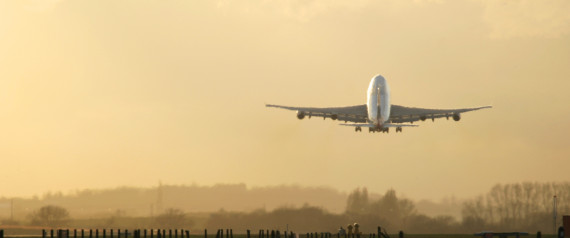
By Bahar Gholipour, Staff Writer
Published: 12/12/2013 02:34 PM EST on LiveScience
London is actually closer, in a sense, to New York than to other British towns, if the traveler is a virus, new research shows.
Using measures of connectivity between airports, rather than actual distances, makes it possible to better predict where an emerging infectious disease will strike next[1] , the researchers of a new study said.
In the study, the researchers defined an "effective distance" between any pair of airports in the world based on the air traffic between them, rather than the miles. The resulting model of disease spread predicted when a newly emerged disease could reach any given place, for both simulated future outbreaks and real epidemics of the past — for example, the 2003 SARS epidemic and the 2009 swine flu[2] pandemic.
The model was also able to quickly identify the origin of an emerging pathogen, which is essential for determining a disease's cause and finding ways to curb its further spread, according to the researchers, whose study will appear tomorrow (Dec. 13) in the journal Science. [5 Scariest Disease Outbreaks of the Past Century[3] ]
"With this new theory, we can reconstruct outbreak origins with higher confidence, compute epidemic-spreading speed and forecast when an epidemic wave front is to arrive at any location worldwide," said study researcher Dirk Brockmann, a theoretical physicist who conducted the research at the Northwestern University. "This may help to improve possible mitigation strategies."
The researchers calculated the effective distances between cities based on air traffic because such traffic reflects how many people travel a certain path, and how often. With the results, patterns of disease spread that once seemed complex start to look simpler, the researchers said.
"If the flow of passengers from point A to point B is large, the effective distance is small," said study researcher Dirk Helbing, a professor of sociology at the Swiss university ETH Zurich. "The only thing we had to do was to find the right mathematical formula for this."
In addition to defining effective distances between airports, the researchers also defined the shortest paths for indirect journeys, and included models of local spread of disease within a city[4] .
Infectious diseases have long been spread across borders by travelers. For historical cases such as the spread of the Black Death in Europe, simple, intuitive models that focused on geographical distances between places could show how a disease spread.
Today, however, travelers are just a few hours' flight from distant destinations, and so physical distance no longer determines how a disease will spread.
In an editorial accompanying the study in the journal, Angela McLean, a professor of mathematical biology at Oxford University in England, wrote that the new model has advantages over previous ways of predicting disease spread.
"Faced with the complexity of the global spread of new infections, a common approach has been to create enormous computer simulations," McLean wrote. Butsuch sophisticated approaches have yielded little insight, she said.
Models of disease spread that are based on a germ's mobility, epidemiological data and disease-specific mechanisms, are also difficult to implement and have limited use if such factors are unknown, which is typically the case with a newly emerging infectious diseases[5] , the researchers said.
In contrast, the new model could predict arrival times for a disease, even if little is known about the microbe that causes it, the researchers said.
"Given the projected growth of passenger numbers[6] over the coming decades, this theory may be able to illuminate how much faster the next SARS or H1N1 will spread as more and more people take to the sky," McLean said.
Email Bahar Gholipour[7] or follow her @alterwired . Follow us @LiveScience , Facebook & Google+ . Original article on LiveScience .[8] [9] [10] [11] [12]
- Video: Time-lapse of new infectious diseases worldwide[13]
- 7 Devastating Infectious Diseases[14]
- 10 Deadly Diseases That Hopped Across Species[15]
Copyright 2013 LiveScience, a TechMediaNetwork company. All rights reserved. This material may not be published, broadcast, rewritten or redistributed. ]]>
References
- ^ emerging infectious disease will strike next (www.livescience.com)
- ^ 2009 swine flu (www.livescience.com)
- ^ 5 Scariest Disease Outbreaks of the Past Century (livescience.com)
- ^ local spread of disease within a city (www.livescience.com)
- ^ the case with a newly emerging infectious diseases (www.livescience.com)
- ^ projected growth of passenger numbers (www.livescience.com)
- ^ Bahar Gholipour (www.huffingtonpost.com)
- ^ @alterwired (twitter.com)
- ^ @LiveScience (twitter.com)
- ^ http://www.facebook.com/#!/livescience (www.facebook.com)
- ^ https://plus.google.com/101164570444913213957/posts (plus.google.com)
- ^ http://LiveScience.com (livescience.com)
- ^ Video: Time-lapse of new infectious diseases worldwide (www.livescience.com)
- ^ 7 Devastating Infectious Diseases (www.livescience.com)
- ^ 10 Deadly Diseases That Hopped Across Species (www.livescience.com)
- ^ Send us a tip (www.huffingtonpost.com)
- ^ Send us a photo or video (www.huffingtonpost.com)
- ^ Suggest a correction (www.huffingtonpost.com)
0 comments:
Post a Comment